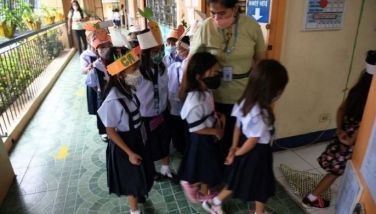Chasing the last speakers of a dying tongue
MANILA, Philippines - I had two flights booked on the same day. One goes to Marrakech, another to Amsterdam. The flight to Morocco had already been booked a few weeks before, even my mind is set that I am to meet Berber people and immerse in the immensity of the Sahara desert.
Days before the Morocco flight, I received an email stating I had been accepted in an international youth conference in The Hague, Netherlands. If only my body can be in Europe and Africa at the same time. But I had to flip the coin.
I found myself landing at Amsterdam Schiphol and taking a connecting train to Den Haag (The Hague). Joining almost a hundred of youth from different parts of the world, we were tasked to deliberate and formulate goals and premises to be passed in the United Nations Headquarters in 2015.
It was the third day of the conference. We spent quite a long time debating about the impossibility of the separation of church and state; criticizing the stratification of languages and agreeing that English should not be made the language of the world if we are to undermine the hierarchy of languages; sharing experiences of our individual countries’ attempt to combat poverty, improve social and economic sustainability, ensure peace and security and mobilize international cooperation.
As we were approaching the last part of the goals deliberation, I noticed that there was no goal or premise specifically addressing culture. I approached the moderator and told him that culture is also essential in formulating the goals because it serves as a common denominator of all the nations in the world; it’s a blueprint of every single human being’s identities.
The moderator asked me to prepare a presentation that will be delivered in the Peace Palace the next day. I began my presentation by mentioning statistics of languages and world heritage sites that are on the brink of extinction.
At present there are 1,007 properties inscribed in the World Heritage List, 45 of those sites are in danger. Africa has the most number of heritage sites in danger comprising 36 percent in the list.
Moreover, according to the United Nations Educational, Scientific and Cultural Organization (UNESCO) Atlas of the World’s Languages in Danger, of the estimated 6,000 spoken languages in the world, 43 percent are endangered. In number, 576 languages are critically endangered of the 2,579 languages in danger.
I also opened my presentation by narrating two stories about Filipino culture; weaving and tattooing.
I narrated an experience that I’ve had in visiting Lubuagan, a town in Kalinga province where back strap weaving is almost endangered due to the elder’s inability of passage to the younger generation and the sustainability lacking in their weaving industry. Moreover, the children are torn between going to school and practicing their tradition.
Likewise, I shared that the tattooing in Kalinga or known as ‘pambabatok’ is also endangered since the oldest tattooer, Whang-Od is already 94 years old and if not passed to the younger generation, ‘pambabatok’ will be forever gone in the cultural heritage of the Philippines if not inscribed or documented at the very least.
Three months after my presentation at The Hague, I packed my backpack and headed to Alabat Island in Quezon Province, an island six hours away from Manila, the capital. It was an opportunity to see in the flesh what my presentation at the Peace Palace was all really about. From a bus to van to a ferry boat and then to a tricycle, I found myself searching for the last speakers of ‘Agta’, one of the 15 languages listed in the UNESCO Atlas of the World’s Languages in Danger.
Timely enough, Jazzel Lauron, a friend from the University of the Philippines studying Linguistics became interested in locating the last speakers of the language and was determined to do a grammatical sketch of their language as a subject of her research.
In 2000, according to the data in the website of UNESCO, there were only 30 speakers of the endangered language left in Alabat Island. Fourteen years have passed and we were skeptic but in a way still hopeful that we will be able to find members of what UNESCO has listed as the ‘Agta’ tribe.
Thanks to the locals of the island of Alabat and after being pointed from one person to another, we found Rosie Susutin Barreno, one of the last speakers of the critically endangered language.
According to her, there are only 10 fluent speakers left and that they identify themselves as Aeta and not Agta. Thus, Aeta can be considered as an endonym for the ethnolinguistic community of the Aetas in Alabat island.
Tagalogs, the largest and the major ethnic group in the Philippines also live in Alabat Island. There is a high level of contact between the Aeta and the Tagalogs thus the Aetas can also speak Tagalog.
The last 10 speakers of the Aeta language are all Rosie’s relatives.
One of Rosie’s relatives told her that she should be ashamed of herself because she did not teach her children to speak their mother tongue. According to her when her first born was about one or two years old, she tried to speak to her using her mother tongue but the child cried and thought of her as a different person because she was speaking a different language. From then on, she did not attempt to speak to her children using Aeta.
The children too are hesitant to learn their mother tongue since they do not see a need for it, especially in an island mostly inhabited by Tagalogs.
Inability of passage is not the only reason why a language is on the verge of extinction but also the threat of another widely spoken language, in the case of the Aetas and in the Philippines, it’s Tagalog.
Intermarriage to Tagalogs also affected the continuity of their pure Aeta bloodline. Rosanna, one of Rosie’s daughters said that she would rather marry a Tagalog rather than an Aeta.
The children do not realize the cultural value of their mother tongue; their minds are framed on the superiority and the economic value of the Tagalog language, the foundation of the national language in the Philippines. Tagalog is the language used in schools, the language that will get them jobs in big cities and the language spoken by the majority in the Philippines.
Of the 15 languages in the Philippines listed in the UNESCO Atlas of the World's Languages in Danger, four have already been extinct and 11 are on the verge of extinction. Documenting a language is not an overnight escapade. Even if the endangered languages will all be archived and documented, if the speakers do not pass it on to the younger generation and find their mother tongue’s intrinsic value within their identity and heritage, extinction will therefore be inevitable.
In Nov. 27, 2014, Rosie Susutin Barreno passed away due to breast cancer. With the lack of health services accorded to indigenous communities in the Philippines, she immediately lost her battle to cancer. She will not be able to pass the language to her children or even to the generation of the Aeta community in Alabat island. With her death, the Aeta language comes closer to its extinction.
- Latest




























